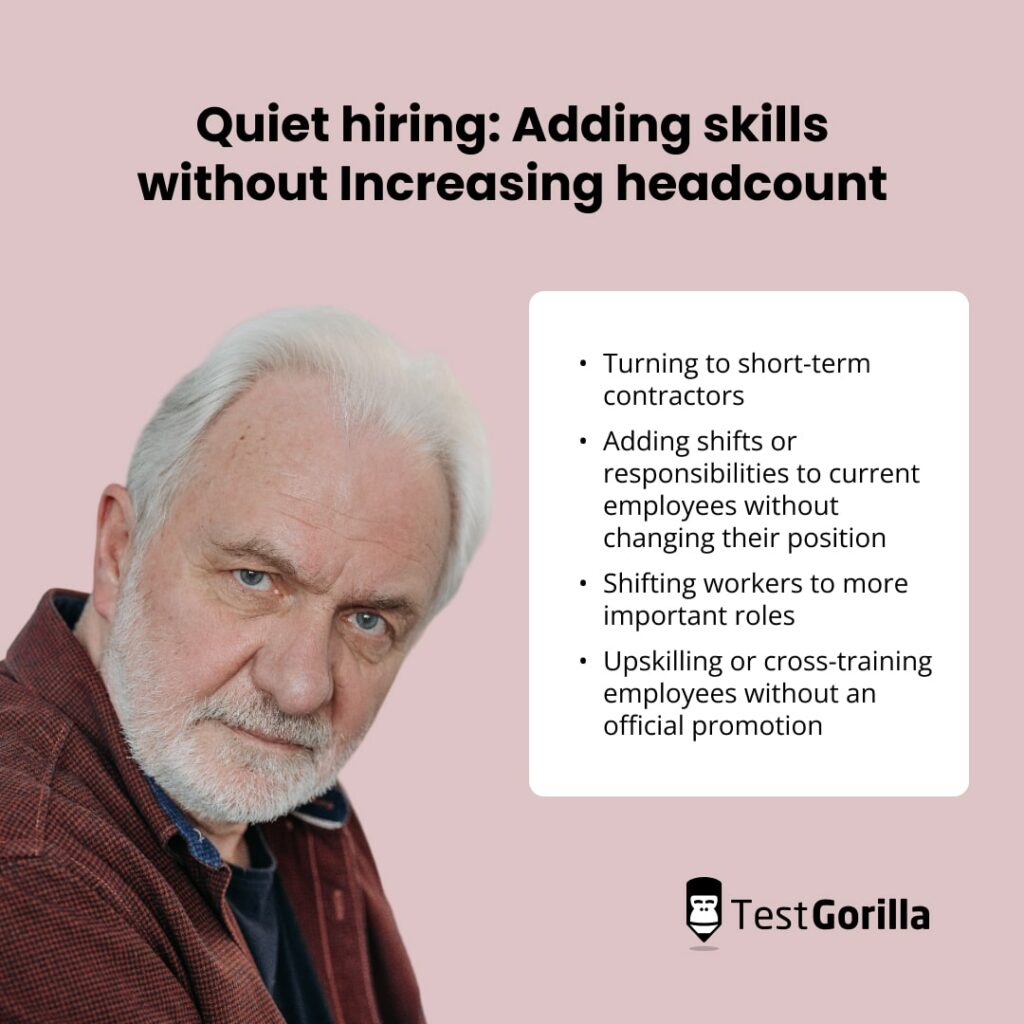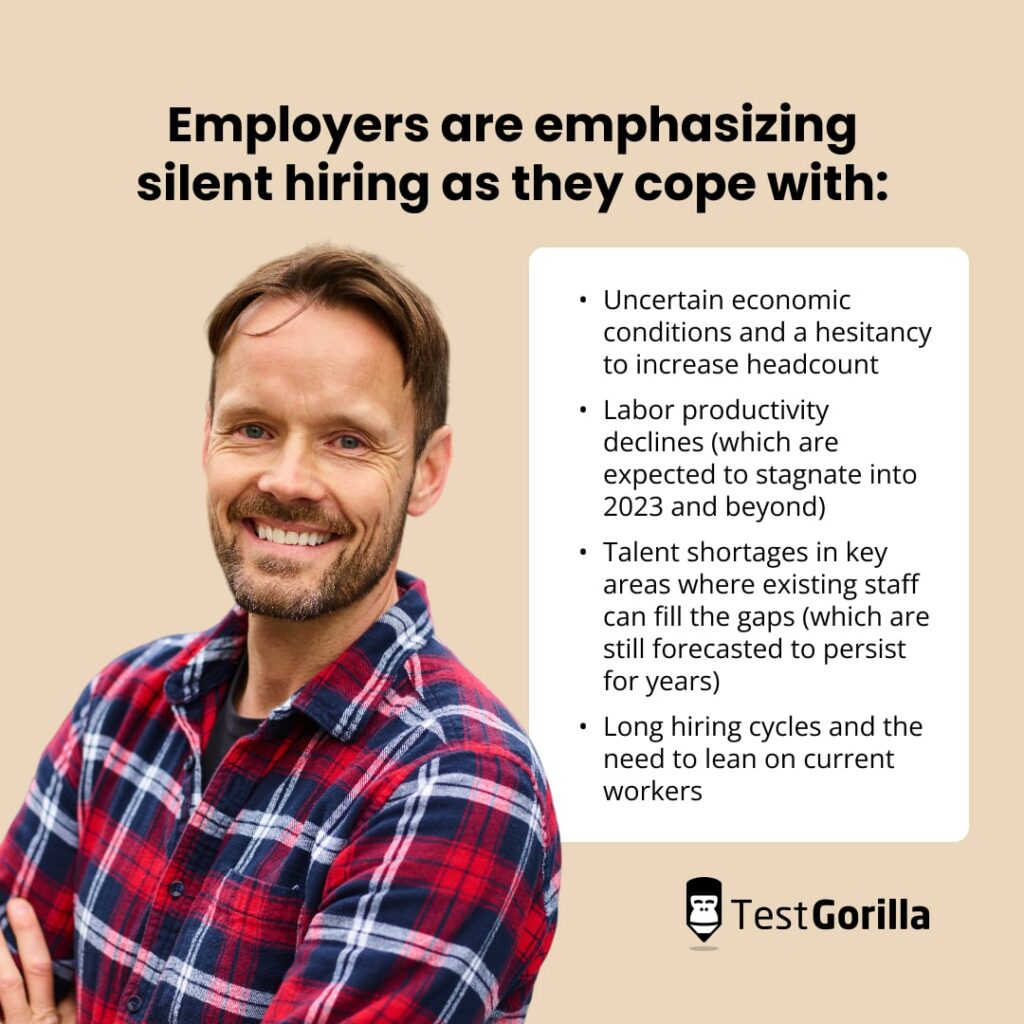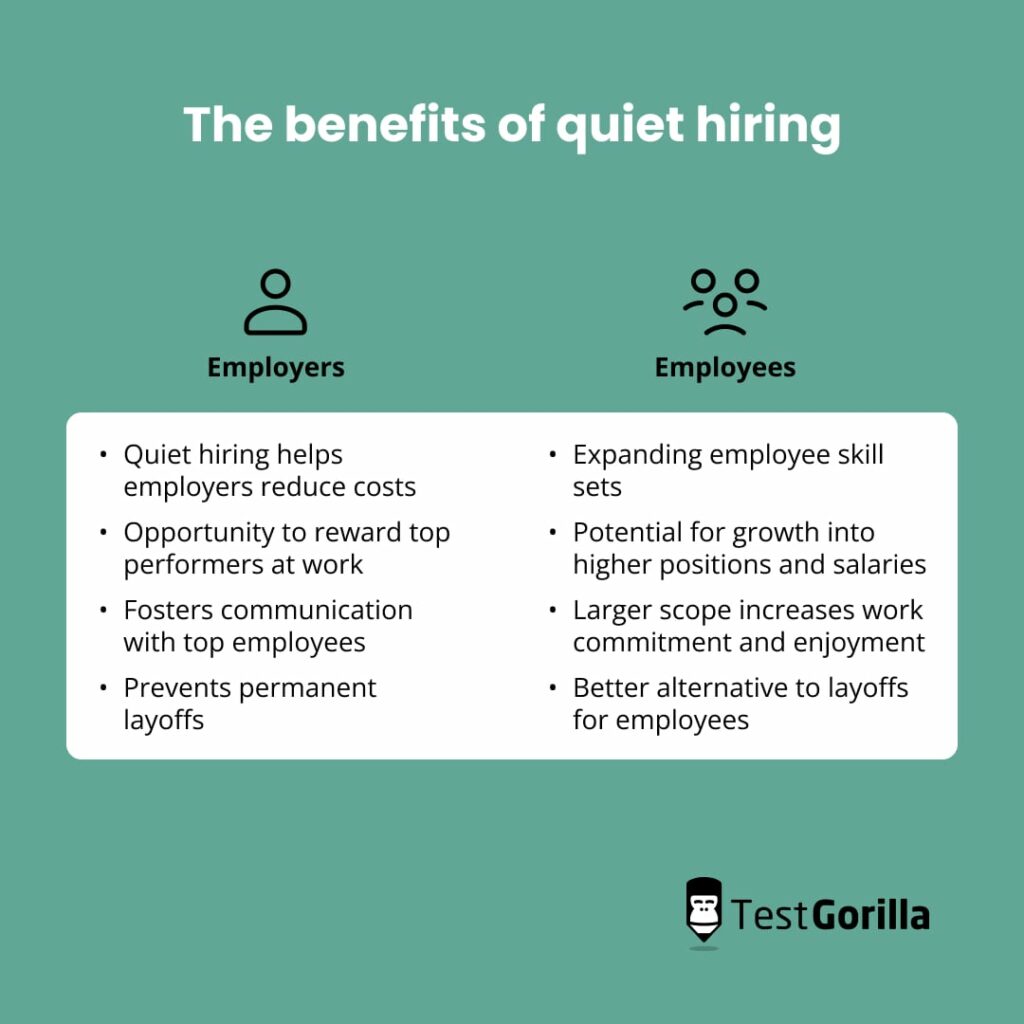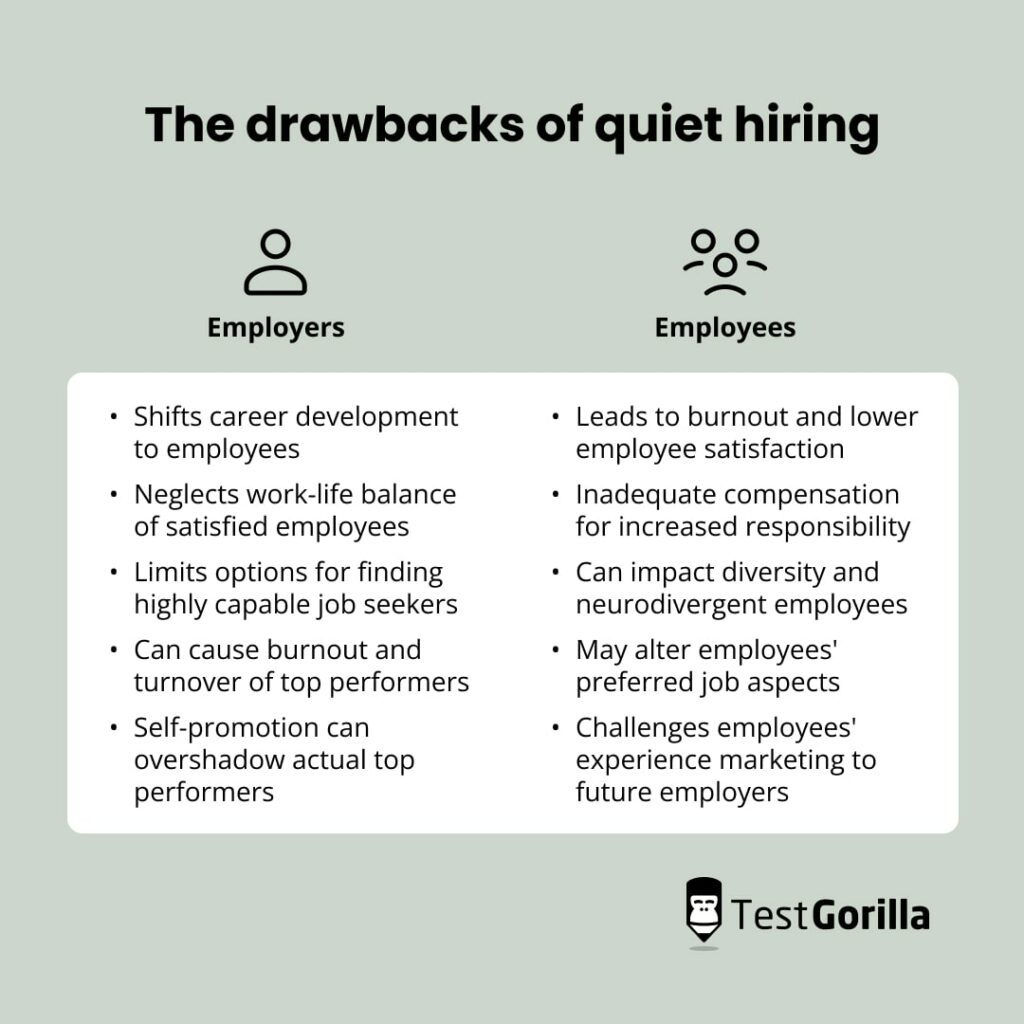In recent years, HR professionals have had to grapple with a slew of workplace trends: First, it was the Great Resignation, then came the Great Reshuffle, all while terms like “quiet quitting” and “quiet firing” entered the mainstream vocabulary.
As if that wasn’t enough, there’s one more “quiet” fad for companies to contend with – this time, it’s “quiet hiring.”
But is quiet hiring a new concept or simply a rebrand of age-old employment practices? And, in either case, is it the solution to a difficult job market faced today or a movement employers should avoid?
To answer these questions and more, we created this guide to explain exactly what quiet hiring means, why companies are practicing it, and whether your company should lean in or steer clear of it.
Regardless of what fad or phrase is in vogue, TestGorilla’s team is always focused on helping employers find, hire, and retain the best-skilled talent for every position, from customer service reps to software engineers.
So, let’s uncover whether quiet hiring runs counter to this mission and help determine how your company can best respond.
Table of contents
What is quiet hiring?
Quiet hiring is when companies shift more responsibilities to existing employees instead of hiring additional workers to satisfy demands. This can happen when employees take on new roles or assume expanded duties.
Quiet hiring seeks to get more output from an employer’s current employees instead of adding to the headcount.
Though, there’s a bit more nuance than what a silly analogy can illustrate.
As it turns out, quiet hiring doesn’t involve much hiring at all. It’s sort of like comparing oat milk with regular milk, except the oat milk, in this case, would come as an empty carton, and you’d be left with the trace leftover milk you have at home instead. Tough luck.
Despite the new name, the practice of quiet hiring has always been an option for HR organizations to balance the supply of talent with the needs of their companies.
Before we jump into the pros and cons of quiet hiring, first let’s consider how employers put quiet hiring into practice.
Examples of quiet hiring
Exactly how quiet hiring takes shape depends on each organization.
Employers can add new skills without increasing headcount in a couple of different ways. For example, instead of hiring new full-time employees, a quiet hiring method might entail:
Turning to short-term contractors
Adding shifts or responsibilities to current employees without changing their position
Shifting workers to more important roles
Upskilling or cross-training employees without an official promotion
To bring this to life, you might imagine a company in the midst of a hiring freeze repurposing its recruiting staff to instead help with corporate communications.
Or, a company might train and reallocate its data science staff to support more pressing tasks in software development.
In all cases, businesses are “quietly” prioritizing their existing talent without public searches for new leaders or large pay raises and title changes.
So why is there a resurgence of focus on this specific angle of workforce management? Current job market conditions can shed some light.
Why are companies turning to quiet hiring?
Doing more with less is a tempting goal for any situation, but it’s especially true for employers facing a precarious economic and labor market environment.
As the global pandemic shifted many to remote work and accelerated the demand for digital innovation, companies responded by hiring lots of necessary new roles.
Now, as things slowly return to normal and the economy grapples with rising inflation and recession worries, many companies, in particular those in the technology sector, are realizing they overhired.[1]
Some companies have turned to layoffs while many more are realigning their workforce to get more output from the employee base they already have.
Employers are emphasizing silent hiring as they cope with:
Uncertain economic conditions and a hesitancy to increase headcount
Labor productivity declines (which are expected to stagnate into 2023 and beyond)
Talent shortages in key areas where existing staff can fill the gaps (which are still forecasted to persist for years)
Long hiring cycles and the need to lean on current workers
In the face of all this, it’s likely companies continue to use the tactic of quiet hiring. But putting that aside, dare we ask, should they?
Let’s consider some potential benefits of quiet hiring and then explore the real costs your company should contemplate before joining this trend.
The benefits of quiet hiring
At face value, quiet hiring seems like a blessing to employers and a curse to employees – more output for the same pay and title.
However, this consideration misses the full picture.
Let’s give quiet hiring an honest chance and consider the benefits for both employers and employees.
Benefits for employers | Benefits for employees |
1. Quiet hiring helps employers reduce costs by eliminating and cutting back on the salary expense that would be needed for a greater headcount. Instead of incurring additional costs to source talent from the open market, employers save money by leveraging their existing workforce. | 1. Employees can take advantage of quiet hiring by using it as a chance to expand their skill sets and work on new areas of the business. Many employees view it just this way, with surveyed in a recent Monster poll agreeing that quiet hiring was “an opportunity to learn new skills.” |
2. Quiet hiring is a chance for employers to identify and reward their highest-performing workers . Often, high-achievers are overlooked during periods of growth, but this is a missed opportunity considering top performers are up to than average employees. | 2. Employees who care to take the long view with their employers can use periods of quiet hiring to take on additional tasks and fill in gaps, thereby demonstrating an ability to grow into bigger roles and higher salaried positions down the line. |
3. When done right, quiet hiring can be a chance for employers to improve communication channels with top employees . Forward-thinking employers can have open conversations about where the business is going and point out areas of opportunity for those interested in working on something new or different. | 3. Somewhat counterintuitively, increased levels of responsibility are often associated with greater levels of ownership and buy-in from employees. Eager employees might find that their commitment to work and enjoyment of work rises with a larger scope. |
4. Quiet hiring can help employers avoid permanent layoffs by realigning the talent they want to retain with the changing needs of their business. Instead of outright contracting, businesses can use this strategy to steady their financial position until it’s right to grow again. | 4. Similar to the employer argument, quiet hiring is a much better outcome for employees if the alternative is being laid off . Given the choice between more work and no work, many workers would prefer the latter and understand the tradeoff their company makes. |
For employers and employees alike, the key to making quiet hiring a positive experience is viewing this period as an investment in talent.
Companies focus on identifying and retaining their top-performing workers while high achievers view the additional workload as a chance to prove themselves in the long term.
The drawbacks of quiet hiring
Unfortunately, whether intentional or not, most companies carry out quiet hiring poorly by stacking work on already overburdened employees and failing to communicate changes properly.
In a scenario like this, employees are right to be upset with quiet hiring. After all, the reward for doing great work shouldn’t simply be more work.
In turn, employers can damage their reputation in the marketplace or cause higher levels of attrition from the best employees they’re hoping to keep.
Let’s look at how the costs of quiet hiring can quickly spiral out of control and be felt by both employers and employees alike.
Downsides for employers | Downsides for employees |
1. Executed improperly, quiet hiring puts the onus of
and
on the employee instead of requiring the company to build training and development programs itself. | 1. By asking employees to take on responsibilities outside their normal day job, quiet hiring often leads to burnout and lower levels of employee satisfaction . |
2. Quiet hiring creates a two-tier system that fails to recognize good employees that are happy with their work-life balance . Quiet hiring often coincides with letting go of underperformers and leveraging high-achievers, leaving employees in the middle forgotten. Employers practicing quiet hiring might see further disengagement from productive team members who aren’t willing to raise their hands for more work. | 2. Normally, companies that practice quiet hiring are not handing out raises, bonuses, or promotions along with additional assignments. Employees are negatively impacted in the sense that they are not properly compensated for the new level of responsibility . |
3. Quiet hiring has a tendency to reward those employees that are louder and better at managing upwards. In this way, quiet hiring might elevate workers who appear most capable instead of those who are most capable based on their actual performance. | 3. Adding more tasks to a worker’s plate without structure and training is destined to overwhelm
employees who are neurodivergent
and create a work environment that is not suited to diverse backgrounds. |
4. Quiet hiring can lead to burnout and cause even the best performers to quit. This might also have a negative consequence on an employer’s reputation in the labor market, m aking future hiring more difficult. | 4. Workers who take on new roles and responsibilities may find themselves being taken away from the part of the job they enjoy the most and applied for in the first place . This can lead to disengagement and a bad employee experience if workers feel a disconnect between what they signed up for and what they’re tasked with doing. |
5. By not hiring externally at all, employers cut themselves off from exploring highly capable employees that are job-searching . Additionally, the demand for talent may be less competitive during times when other companies feel pressured to “quiet-hire.” Companies that continue their talent acquisition efforts may be able to onboard new hires less expensively. | 5. Employees who take on more than one role or are given responsibilities that straddle multiple functions may find it difficult to summarize and neatly market their experience to future employers . “Jack-of-all-trades” isn’t a title that stands out to recruiters, even if it fairly encapsulates the wide variety of tasks employees take on during periods of quiet hiring. |
Given the fine line between quiet hiring being a win-win proposal for employees and employers or a clear lose-lose proposition, you might wonder if there is a better alternative.
How else can employers get more out of their workforce without upsetting the talent they so desperately want to hold onto?
Good question. We have three solutions.
The three better alternatives to quiet hiring
Before your company jumps on the quiet hiring bandwagon, it’s worth considering some better alternatives.
Employers who want greater productivity with lower costs shouldn’t be squeezing their existing labor force for every last ounce of output.
A better strategy focuses on getting more value out of internal mobility and making targeted and cost-conscious hiring decisions.
We suggest avoiding this latest HR fad, and we instead encourage companies to accomplish their goals by:
Being intentional about their internal talent mobility strategy
Using skills-based hiring practices to recruit staff more effectively
Relying on contractors to fill gaps when external hires are too expensive or there is a specialized need
When combined, all three approaches work in tandem to create a strong talent base at your company.
1. Be open, loud, and direct about your internal talent mobility strategy
Forcing employees to take on more tasks and work harder is a high-risk strategy that can quickly lead to a disengaged or absent workforce.
Instead of quietly pressing harder on your best performers and hoping nothing breaks, employers should double down on career development and an internal mobility strategy.
We’ve written an extensive guide to internal mobility elsewhere, but we want to make sure to show the highlights as they relate to quiet hiring.
A good internal mobility strategy focuses on identifying skills gaps across your organization and creating processes to source the right talent from your internal workforce.
Additionally, your internal mobility strategy should emphasize:
Upskilling and reskilling existing staff
An internal talent marketplace for easy sourcing
Fair and equitable pay
A stop to talent hoarding
All of these components create a flexible workforce that can adapt to changing needs. So instead of burdening the same high-performers routinely, there’s already a process for employees to raise their hands for new responsibilities.
A good internal mobility strategy flips quiet hiring on its head and creates the opposite of quiet quitting – the right workers elect themselves to grow into new roles.
2. Use skills-based hiring to recruit staff externally and fill key positions
The pressure to resort to quiet hiring practices for companies often comes down to cost.
For one thing, businesses see the potential to forego an entire salary and benefits package if other workers can fill in the gaps of a new hire.
But indirect costs are also on employers’ minds when it comes to quiet hiring, such as:
Recruitment costs to make new hires, like expenses for outside placement firms, internal HR, or recruitment tools
The time and energy it takes to source candidates, interview candidates, and ultimately fill a new role
Hidden costs from hiring the wrong person including cultural damage, lost productivity, and needing to rehire
Considering the real and perceived expenses of external hires, it’s not surprising that some companies emphasize quiet hiring instead.
However, sometimes external hires are the only way to avoid the drawback of alienating your existing workforce and causing long-term damage to your company.
And more importantly, there’s a way to hire externally that limits additional costs and provides an efficient method to attract the talent your company needs.
Skills-based hiring practices provide employers with an objective way to assess external candidates and place new employees quicker, cheaper, and more effectively than traditional hiring methods.
In fact, out of the more than 2,700 employers surveyed in our annual thought-leadership study:
89.8% saw a reduction in cost-to-hire
91.4% saw a reduction in time-to-hire
92.5% saw a reduction in mis-hires
Plus, with skills-based hiring, your company doesn’t just save money and time on the front-end but continues to benefit throughout an employee’s lifecycle with 91.2% of organizations reporting an increase in employee retention.
Instead of quiet hiring, companies can use skills-based hiring to reduce costs and find the top talent they need faster without the potential downsides.
3. Rely on contractors to fill gaps only when completely necessary
Even companies with efficient hiring practices and skilled employees need supplemental support at times.
For example, businesses that face seasonally high periods of demand can’t hire (and then fire) permanent employees to adjust to busy times.
Or, other businesses may not be able to justify a full-time position but still require help in technical areas such as using Photoshop or maintaining Cybersecurity.
“Quietly” asking for more out of an employee base that doesn’t have the skills or bandwidth in these scenarios isn’t the solution.
Instead, companies are better served finding contingent and project workers to fill in the gaps.
Talented part-time staff can be a useful pressure release valve for hiring and training needs.
However, companies shouldn’t pursue this strategy in absence of building better internal mobility and more efficient talent acquisition processes.
Rather, temporary workers are better thought of as the third leg of a high-performing HR function.
Quiet hiring is just a band-aid for sustainable hiring practices
The quiet hiring trend is often explored from two extremes…
On one end, it’s seen as a manipulative employment practice for employers to gain back power and demand more out of their employees.
On the other, it’s a tactful strategy for companies to retain their best employees during tough times and give them interesting growth opportunities.
We tend to be more critical, but the truth ultimately depends on how an organization treats its workforce.
More importantly, however, in either case, quiet hiring is simply a temporary solution. Companies who care about building a deep bench of talent know that they need to consistently incorporate new capabilities through internal and external sources.
So if you’re ready to develop a talent strategy that acknowledges the constant need for capable employees, TestGorilla is waiting to help with our research-backed hiring assessments and other HR resources.
Buck the trend and proudly attract talent that will benefit your company over the long term!
Source
1. Blum, Sam. (December 6, 2022(. “How over-hiring during the pandemic led to the rash of layoffs in 2022”. HR Brew. Retrieved March 28, 2023. https://www.travelperk.com/blog/top-hybrid-work-trend-stats-from-global-companies/
Related posts
Hire the best candidates with TestGorilla
Create pre-employment assessments in minutes to screen candidates, save time, and hire the best talent.
Latest posts
The best advice in pre-employment testing, in your inbox.
No spam. Unsubscribe at any time.

Hire the best. No bias. No stress.
Our screening tests identify the best candidates and make your hiring decisions faster, easier, and bias-free.
Free resources
This checklist covers key features you should look for when choosing a skills testing platform
This resource will help you develop an onboarding checklist for new hires.
How to assess your candidates' attention to detail.
Learn how to get human resources certified through HRCI or SHRM.
Learn how you can improve the level of talent at your company.
Learn how CapitalT reduced hiring bias with online skills assessments.
Learn how to make the resume process more efficient and more effective.
Improve your hiring strategy with these 7 critical recruitment metrics.
Learn how Sukhi decreased time spent reviewing resumes by 83%!
Hire more efficiently with these hacks that 99% of recruiters aren't using.
Make a business case for diversity and inclusion initiatives with this data.























